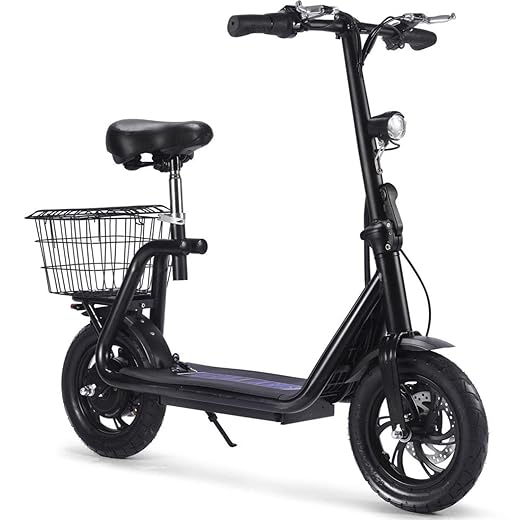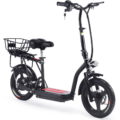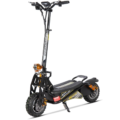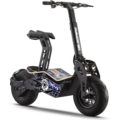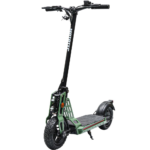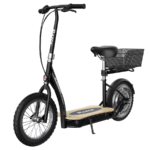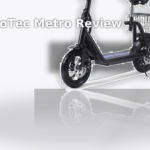- Home
- Scooters
- Electric Scooters
- MotoTec Metro
MotoTec Metro
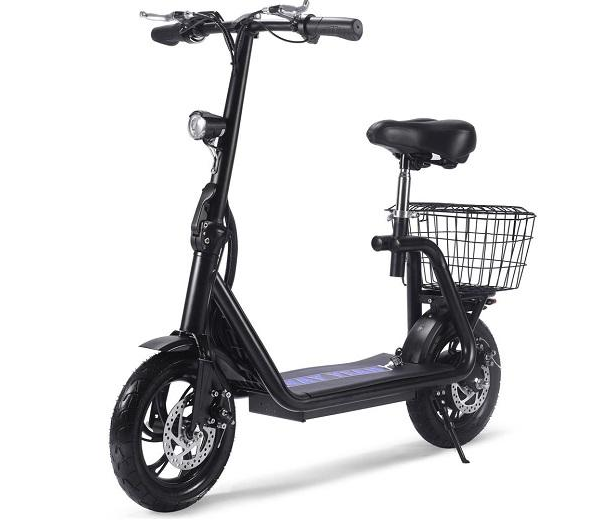

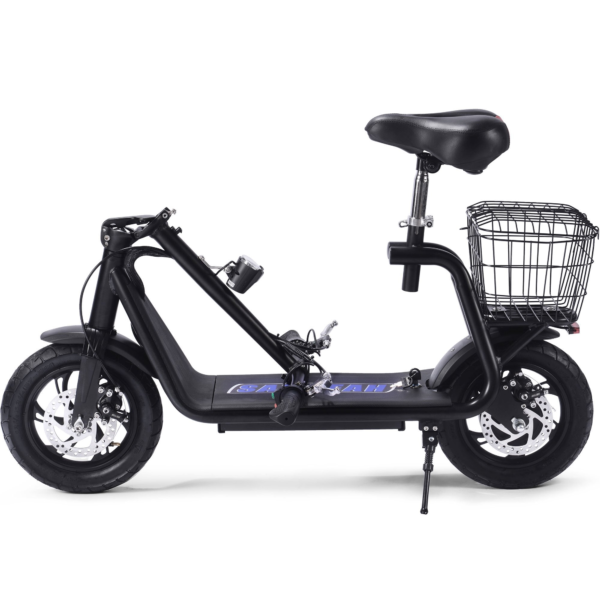
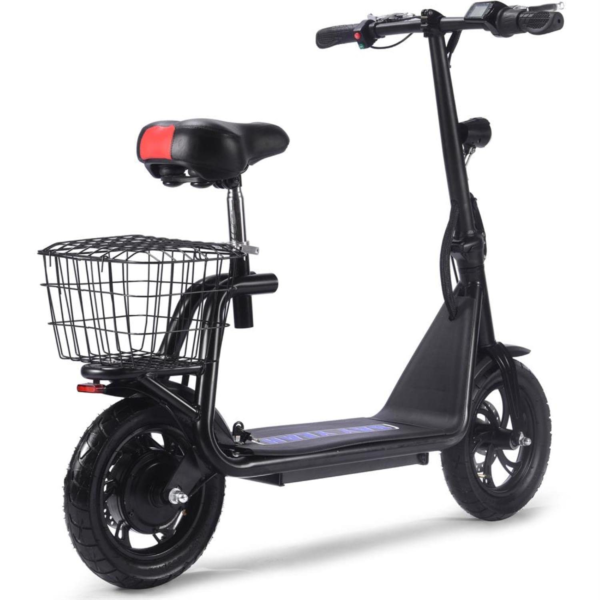
- Battery Range: 10–15 miles (16–24 km)
- Top Speed: 15 mph (24 km/h)
- Motor Power: 500 W
- Weight Capacity: 200 lb (90.7 kg)
- Charging Time: ~4–6 h
- Scooter Weight: 38.0 lb (17.2 kg)
PROS
- 500W brushless rear hub motor
- 12″ pneumatic tires
- Front & rear disc brakes
- LED headlight & taillight
- Foldable handlebars for storage
- LCD display for speed/battery/distance
CONS
- Only 15 mph (24 km/h)
- 10–15 mile (16–24 km) range
- No IP rating specified
- Portability just average at ~38 lb
Key Takeaways
- The MotoTec Metro is a compact, folding electric scooter designed for city commuting with big 12-inch tires.
- It features a 36-volt, 500-watt brushless motor, offering a top speed of 15 mph and a range of 10-15 miles per charge.
- With an easy-to-use twist throttle and bike-like controls, it suits both new and experienced riders well.
- The scooter has practical features like disc brakes, a flat deck for comfort, and a folding design for portability.
- While great for short commutes, it isn’t ideal for steep hills or long rides over 15 miles.
Table of contents
- What Is the MotoTec Metro?
- How the MotoTec Metro Works
- Key Specifications
- Design & Build Quality
- Performance Fundamentals
- Battery, Range & Efficiency
- Ride Quality & Comfort
- Braking & Safety Features
- Portability & Daily Usability
- Maintenance & Care
- Weather & Seasonal Considerations
- MotoTec Metro vs Alternatives
- Who the MotoTec Metro Is (and Isn’t) For
- FAQs
- Glossary
- Why the Metro works for everyday riders
- Practical setup tips for the first week
- Troubleshooting quick guide
- Long-term ownership notes
The MotoTec Metro is a simple city scooter with big 12-inch tires and an easy twist throttle. It fits short commutes, school runs, and quick errands. It favors comfort, steady control, and low fuss. And new riders settle in fast while daily riders enjoy a quiet, smooth flow.
What Is the MotoTec Metro?
The MotoTec Metro is a compact, folding electric scooter for paved streets and mixed urban paths. It runs a 36-volt brushless rear hub motor rated at 500 watts and a 36 V lithium-ion battery. The frame carries wide 12-inch pneumatic tires that soak up rough pavement better than small wheels. So it stays stable at neighborhood speeds. The deck is flat and grippy, and the bars fold for storage or a train ride.
This scooter targets riders who want practical A-to-B travel in busy areas. It keeps the power modest and the chassis friendly. The twist throttle feels like a bicycle grip, and the brake levers mirror a bike. So your hands learn the layout in minutes. The package includes a headlight, a rear light, and an LCD that shows speed, distance, and battery level. Then you get a clean, quiet ride that fits small apartments and car trunks.
How the MotoTec Metro Works
Power starts at the 36 V pack, flows through a controller, and lands in the rear hub motor. The controller meters current in short pulses and sets torque. So throttle changes feel smooth, and acceleration comes in a steady wave.
The twist throttle sends a position signal to the controller. Then the controller ramps current to the brushless hub in steps that limit surge. That pacing helps traction and preserves battery life. The motor sits inside the rear wheel, so there is no chain to clean. So noise stays low and moving parts stay simple.
The battery stores energy for your trip. A 12 Ah pack at 36 V equals 432 Wh on paper. Real-world output sits lower, as it always does. Even so, the rated range fits daily hops. You plug the charger into the port on the frame. Then a full cycle takes about an evening.
Brakes handle the other half of speed control. The Metro uses front and rear mechanical disc brakes with cable actuation. Lever feel is clear, and bite builds in a linear way. So you sense pad contact long before a wheel locks. The large tires add grip under load, which helps keep stops calm and straight.
Key Specifications
| Block | Details |
|---|---|
| General | Form: Folding electric kick scooter; Wheel size: 12 in pneumatic (air-filled); Display: LCD for speed, battery, distance |
| Performance & Power | Motor: 36 V 500 W brushless rear hub; Top speed: 15 mph (24 km/h); Rated climb: ~10°; Drive: single rear hub |
| Battery, Charging & Electrical | Battery: 36 V 12 Ah lithium-ion (432 Wh); Charger input: AC 110–240 V, 50/60 Hz; Charge time: 4–6 hours; Lights: LED headlight and tail light |
| Build & Dimensions | Size: 45 × 21 × 38 in (114.3 × 53.3 × 96.5 cm); Folded: ~48.0 × 10.2 × 23.6 in (1220 × 260 × 600 mm); Tires: 12 in pneumatic; Frame: steel |
| Safety & Control | Brakes: dual mechanical disc front and rear; Reflectors: not specified; Water resistance: not specified |
| Features & Extras | Foldable handlebars; LCD trip data; Kickstand; Rear carry rack; Cruise control: not included |
| Warranty & Compliance | Max rider load: 200 lb (91 kg); Product weight: 38 lb (17.2 kg); Warranty: 30-day parts replacement |
Use these specifications as a quick reference for setup, storage, and routine checks.
Design & Build Quality
The Metro favors function over flash. The steel frame looks plain on purpose. Welds are tidy, and the deck forms a flat, comfortable platform. Grip tape keeps shoes planted in rain and sun. And the stem locks with a robust hinge. Then the bars fold along the deck for narrow storage in a hallway or trunk.
The cockpit is clean. A twist throttle sits on the right, and brake levers sit on both sides. The LCD sits where you can scan speed and battery without losing the path. The wiring follows the stem in a protected run near the hinge. You can lift the scooter by the stem for short carries. So the 38-pound mass feels manageable on a stair or two.
Large 12-inch pneumatic tires define the ride. They add height, roll over cracks with less drama, and cushion bumps. The rims are sturdy, and sidewalls support urban pressures without squirm. The kickstand swings down with a solid snap and holds the scooter at a steady lean. Then the rear rack gives you a spot for a small bag or U-lock.
Fit and finish match daily use. Paint resists scuffs from locks and racks. Fasteners sit where common tools can reach them. The frame geometry supports a neutral stance. So the package feels complete for short city trips.
Performance Fundamentals
The Metro steps off the line with a calm push. Low-end torque is smooth, and throttle response stays linear through mid-speed. You feel a steady pull rather than a surge. So balance stays easy for new riders, and traction holds on paint and grit.
Cruising at 10–15 mph feels planted. The wheelbase and big tires keep small bumps from bouncing the chassis. Then the bars track straight while the deck stays quiet. The scooter does not chase ruts the way small-wheel models do. So your hands relax, and your stance stays easy.
Hill starts on mild grades feel fair for a 500 W hub motor. On a 7–10% city climb, speed drops yet progress continues. A short kick at the start helps load the motor cleanly. Long, steep grades ask for patience. So plan lines that reduce stops on climbs. Then let the motor cool on flats to hold pace over the whole route.
Top speed lands at an honest neighborhood rate. Wind hiss rises first, not chassis shake. The Metro feels most comfortable on streets and campus paths where flow matters more than bursts.
Battery, Range & Efficiency
A 36 V, 12 Ah pack offers practical daily range. The published figure sits in the 10–15 mile band, or about 16–24 km. Rider weight, hills, stops, and temperature shift the result. Cold air trims available power, and headwinds raise demand. So tire pressure matters more than most expect.
Plan for a comfortable 8–12 mile round trip unless your route is flat and warm. Then stretch to the top end with smooth pacing and fewer full-throttle pulls. The Metro rewards steady speeds. So keep cruise in the mid-teens and keep stops short.
Charging takes 4–6 hours from low. Top-off sessions run faster. It helps to unplug within an hour of full to limit heat. Store the scooter at room temperature. Then avoid hot cars or damp basements. The pack stays happier near mid charge, and a weekly full cycle keeps the gauge honest.
Ride Quality & Comfort
Ride comfort is the highlight. The 12-inch tires roll through pothole lips that jar small scooters. Curbs with smooth ramps feel easy. Expansion joints pass with a single thud, not a rattle. So the stem stays steady, and the deck stays quiet.
Grip tape helps your stance. The deck length gives room for a staggered foot position that lowers fatigue. Bar width suits control at low and mid speeds. The levers sit within easy reach for one-finger taps or two-finger hard stops.
The scooter lacks suspension, yet the big tires act like simple air springs. Pressure tuning shifts the feel. Slightly lower pressures improve comfort, and higher pressures sharpen steering. So use the sidewall range and your weight to find a sweet spot. Recheck every two weeks, since slow air loss can cut comfort and range.
Stem flex sits in a calm band. You may feel a touch of give under hard braking and rough patches. Even so, the hinge locks tight when maintained. So steering stays precise for a city run.
Braking & Safety Features
The Metro runs dual mechanical disc brakes. The front lever bites early and sets weight on the front tire. The rear lever trims speed and adds control. Use both levers for the quickest, straightest stops. Lever travel is short and predictable. So you can trail-brake into tight turns without sudden lockup.
Lighting covers basic needs. The LED headlight helps in low light, and the tail light marks your position. Add a bright helmet light for routes with poor street lighting. Treat reflectors as a must on city nights. If your frame lacks them, add stick-on reflectives on the deck or fork.
Wet roads lengthen stops and reduce tire grip. Ride slower in rain. Brake earlier and straight. Then avoid painted lines and metal plates.
Portability & Daily Usability
Portability is a core strength. At 38 lb (17.2 kg), the Metro carries up short stair flights and fits in a trunk. The bar fold shrinks width to about 10 in (26 cm), which slides between car seats and closet shelves. The folded length near 48 in (122 cm) works in hallways if you park parallel to a wall.
Daily use stays simple. Flip the latch, swing the bars up, and lock the hinge. Press power, check battery on the LCD, and roll. The rear rack holds a small bag or lock. So your pockets stay free. The kickstand drops fast and keeps the scooter stable on mixed pavement.
For security, treat it like a bike. Use a hardened U-lock through the frame and a cable through a wheel if you must park outside. Bring the scooter inside at night. Then drop a small tracker in your bag if you park in a shared bike room.
Maintenance & Care
Set a light, repeatable schedule:
- Before rides: Check tire pressure with a gauge. Spin wheels to spot debris. Squeeze levers to feel crisp bite.
- Weekly: Wipe the frame and fork. Check rotor bolts and hinge bolts for snug fit. Clean and lube brake cables if they feel gritty.
- Monthly: Check pad wear and rotor alignment. Center calipers with a thin business card as a spacer.
- Every 3 months: Inspect the throttle and display wiring along the stem. Tighten the headset if you feel play during a front-brake test.
Keep the charger and port clean and dry. Let the scooter cool for 15 minutes after hard rides before charging. Then store near half charge if you will pause riding for a week or more. These small habits protect range and punch.
Weather & Seasonal Considerations
Rain, heat, and cold change range and grip. The Metro does not list a formal water rating. So avoid heavy rain and deep puddles. Dry the scooter after wet rides. Then reopen the hinge and wipe moisture from hidden edges.
Cold air trims voltage under load. Expect less range in winter, and pre-warm the scooter indoors before a ride. Heat raises battery stress. So park in the shade on hot days, and let the pack cool before a charge. Salt on winter streets speeds corrosion. Then rinse and dry metal parts after salty rides.
Tire choice plays a role in grip. The stock pneumatic tires handle mixed pavement well. Keep tread fresh and pressures in the recommended band. So traction stays predictable across seasons.
MotoTec Metro vs Alternatives
The Metro stands out in the big-wheel city group. The 12-inch tires bring comfort without complex suspension parts, so maintenance stays light across a season. The 500 W motor and 36 V pack keep weight down and cost in check, and new riders like the calm start and clear brake feel.
Small-wheel commuters trade comfort for less mass. They fold shorter and weigh less, yet they shake more over rough blocks. Performance scooters add voltage and bigger motors. They climb better and sprint faster, yet they add mass and complexity. Off-road models bring knobby tires and tall frames that do not fold as small. So the Metro sits in the middle as a city tool that fits apartments and mixed travel days.
Pick the Metro when ride feel, wheel size, and simple upkeep top the list. Choose a higher-power class if your route holds long, steep hills or if you want 20+ mph (32+ km/h) cruise. For more torque and top speed from the same maker, consider the MotoTec 2000W 48V Electric Scooter. If you prefer a seated, bike-like cruiser for relaxed paths and errands, the Razor EcoSmart Metro fits that role well.
Who the MotoTec Metro Is (and Isn’t) For
Great for:
- City riders who want steady 10–15 mph travel with low fuss.
- Students who split days between campus paths and buses.
- New riders who want a twist throttle and bike-like controls.
- Multi-modal travelers who need a fold that plays well with trunks and trains.
- Short commutes within 8–12 miles (13–19 km) round trip on mostly flat routes.
Not ideal for:
- Riders who want fast climbs on long, steep grades.
- People who ride in heavy rain or need a published water rating.
- Anyone who needs more than 15 mph cruise on wide suburban roads.
- Long-range riders who push 15+ miles (24+ km) per charge without a top-off.
FAQs
Is the Metro good for beginners?
Yes. The twist throttle, calm launch, and big tires build confidence fast. Brakes feel clear, and the deck gives stable footing.
How far can it go on one charge?
Plan for 10–15 miles (16–24 km) under typical city use. Range drops in cold weather and on routes with many stops and hills. So keep tires firm and pace steady.
What tire pressure works best?
Set pressures within the sidewall range. Start near the middle. Then test a short loop and adjust a few psi for comfort or sharper steering.
Does it have cruise control?
No. The control layout is simple: twist throttle, dual brake levers, and an LCD for speed and battery.
What is the recommended rider weight?
The rated max load is 200 lb (91 kg). Stay within that figure for best braking, range, and handling.
Is there a water-resistance rating?
A formal IP rating is not listed. So avoid heavy rain and standing water, and dry the scooter after wet rides.
Where can I find a quick “MotoTec Metro overview”?
Right here. This page collects specs, fit, ride feel, and care tips in one place.
Glossary
- Ah (amp-hour): Battery capacity. Higher Ah means more stored charge.
- Wh (watt-hour): Voltage times amp-hours. A simple measure of energy.
- Brushless hub motor: Motor built into the wheel with no brushes to wear.
- Controller: Electronics that meter power from battery to motor.
- Regen: Regenerative braking that returns energy to the pack. Not present here.
- Stem flex: Small movement in the steering column under load.
- IP rating: Code that shows dust and water resistance.
- Pneumatic tire: Air-filled tire that cushions bumps and improves grip.
- Mechanical disc brake: Cable-actuated disc brake with clear lever feel.
- LCD: Screen that shows speed, battery level, and trip data.
- Grade: Slope of a hill. A 10% grade rises 10 m over 100 m.
- Torque: Rotational force that gets you moving.
- Top speed: Highest speed on level ground in still air.
- Folded size: Dimensions when the scooter is folded for storage.
- Load rating: The maximum rider and cargo weight the scooter can carry.
Why the Metro works for everyday riders
The Metro wins on basics. You get large wheels, steady brakes, and a simple control set. It keeps the pace friendly on busy streets and mixed paths. So rides feel calm rather than frantic. The chassis is robust, and the parts are easy to service at home. You top off the battery, pump the tires, check the pads, and ride. That routine fits real life.
The big wheels and steel frame shrug off daily bumps. The fold still fits tight spaces. The twist throttle gives fine control in crowds and parking lots. The brake levers tell your hands what the pads are doing at each step. So you stop where you planned, even in short spaces.
Short daily trips make the most of the 36 V system. A lunchtime top-off sets you up for the ride home. Weekends call for relaxed loops through parks and greenways. The scooter’s comfort and quiet add to the easy flow. You finish your route feeling steady and ready for the next errand.
Practical setup tips for the first week
- Bars and levers: Rotate the bars until your wrists stay straight while you stand on the deck. Set brake levers at a comfortable angle. Then tighten clamps evenly.
- Tire pressure: Start near the middle of the sidewall range. Add or drop 2–3 psi after a test loop. So you can lock in a pressure for the season.
- Brake bed-in: Find a safe stretch. Do ten medium stops from 10–12 mph. Pads seat to rotors, and lever feel improves.
- Battery routine: Charge to full before the first ride. For daily use, unplug within an hour of full. Then avoid storing at 100% for long periods.
- Fastener check: Recheck the stem hinge bolts, rotor bolts, and rack bolts after the first 20 miles (32 km).
Troubleshooting quick guide
- Soft or long lever travel: Center the caliper. Reset cable tension at the barrel adjuster. Replace pads if the backing plate nears the rotor.
- Speed drops fast on hills: Use a short kick to start. Keep pace steady. Check tire pressure.
- LCD shows full yet range feels short: Ride to the low-battery warning once, then charge to full to recalibrate the gauge.
- Wobble at speed: Check tire pressure and bead seating. Inspect the hinge for play and tighten per the manual.
- Squeal under braking: Clean rotors with isopropyl alcohol. Lightly de-glaze pads, then bed-in again.
Long-term ownership notes
The Metro rewards light, regular care. Keep a small kit with a pump, hex keys, a T25 Torx for rotors, alcohol wipes, and spare pads. Log tire pressure and pad checks on your phone. Then refresh cables each season, and swap tires when tread blocks round off. The battery prefers mild temperatures and moderate charge levels during storage. Follow those habits, and the scooter stays strong across long months of city use.
A quick heads-up on numbers and real streets. Published figures set the baseline. Real streets set the rest. Weight, wind, grade, stops, and temperature change results. So treat listed figures as targets and use your route to tune expectations. The Metro’s large wheels, firm brakes, and calm motor map well to daily rides, which is why many riders pick it for short city trips.
Specifications
General
| Model The Model specifies the exact version or name of the scooter. It helps identify its unique design, features, and specifications within the manufacturer’s product line. Knowing the model makes it easier to compare options, find compatible accessories, or look up support information. | Metro |
| Brand The Brand identifies the manufacturer or company that designs and produces the scooter. A trusted brand is a sign of quality, reliability, and good customer support. Well-known brands often have higher standards for safety, performance, and after-sales service, giving you more confidence in your purchase. | MotoTec |
| Release Date The Release Date indicates when the scooter model was officially launched on the market. This helps you know how current the design, technology, and features are. A newer release date often means updated components, improved performance, and the latest safety or smart features. | 18 November 2025 |
| Recommended Age Recommended Age indicates the minimum age range that the scooter is designed for, based on safety, size, and ease of use. Following the recommended age helps ensure that riders can handle the scooter’s speed, weight, and controls comfortably and safely. Always check local laws and use protective gear, especially for younger riders. | +16 |
Performance & Power
| Motor Power (Wattage) What it means: The motor power, measured in watts (W), shows how strong the scooter’s electric motor is. Why it matters: Higher wattage usually means better acceleration, more torque, and improved performance on hills or rough terrain. For example, a 250W motor is good for flat city roads and light riders, while a 500W or 1000W motor provides more power for faster speeds or climbing steep inclines. | 500 W rear hub (brushless) |
| Top Speed The Top Speed indicates the maximum speed that the scooter can reach under optimal conditions. It’s usually measured on level ground with a fully charged battery and an average rider weight. A higher top speed allows you to travel longer distances faster, but always ensure you ride within legal speed limits and your personal comfort zone for safety. | 15 mph (24 km/h) |
| Battery Capacity Battery Capacity refers to the total amount of energy the scooter’s battery can store, usually measured in ampere-hours (Ah) or watt-hours (Wh). A higher battery capacity means you can ride longer distances on a single charge, reducing the need for frequent recharging. Keep in mind that actual range can vary depending on rider weight, terrain, speed, and weather conditions. | 36 V 12 Ah (432 Wh) |
| Estimated Range per Charge The Estimated Range per Charge indicates the average distance the scooter can travel on a single full battery charge. This range is calculated under optimal conditions, such as flat terrain, moderate speed, and average rider weight. Real-world range may vary depending on riding style, terrain, weather, and load. A longer range means fewer recharges and greater freedom for longer trips. | 10–15 miles (16–24 km) |
| Hill Climb Ability Hill Climb Ability describes the maximum incline or slope that the scooter can handle while maintaining stable performance. It’s typically expressed as a percentage or in degrees. A higher hill climb rating means the scooter can tackle steeper hills without losing too much speed or power. Actual climbing performance may vary based on rider weight, battery charge, and terrain conditions. | Not specified |
| Drive System The Drive System refers to how power from the motor is delivered to the wheels. Electric scooters typically use either a hub motor (directly integrated into the wheel) or a chain/belt drive system. A high-quality drive system ensures smooth acceleration, efficient power transfer, and low maintenance. The choice of drive system affects performance, noise level, and overall ride experience. | Rear hub (RWD) |
Charging & Electrical
| Charging Time Charging Time indicates how long it takes to fully recharge the scooter’s battery from empty to 100% using the standard charger provided. Faster charging means less downtime and more time on the road. Actual charging time may vary slightly depending on battery capacity, charger output, and environmental conditions. | Approx. 4–6 hours |
| Battery Type Battery Type refers to the specific technology used in the scooter’s battery, which affects performance, lifespan, weight, and charging time. Most modern electric scooters use high-quality lithium-ion (Li-ion) batteries because they offer a good balance of energy density, durability, and low maintenance. A reliable battery type ensures consistent power delivery and longer riding ranges. | Lithium-ion pack |
| Removable Battery A Removable Battery means the battery pack can be easily detached from the scooter for convenient charging and replacement. This feature allows you to charge the battery separately, swap it with a spare for extended range, or securely store it indoors in extreme weather. Removable batteries add flexibility and make it easier to keep your scooter powered up wherever you are. | Non-removable internal battery (fixed pack) |
| Regenerative Braking Regenerative Braking is an energy-saving feature that converts some of the energy normally lost during braking back into battery power. When you slow down or brake, the motor works in reverse to generate electricity, which helps extend the scooter’s range and improves overall efficiency. This system also reduces wear on traditional brake components, leading to lower maintenance over time. | No |
| Lighting Lighting refers to the built-in front and rear lights that enhance visibility and safety when riding in low-light conditions or at night. Good lighting helps you see the road ahead and ensures that other road users can see you. Many scooters include LED headlights, taillights, and sometimes brake lights or side reflectors for added safety and compliance with local traffic regulations. | LED headlight & taillight; LCD display |
Build & Dimensions
| Scooter Weight Scooter Weight refers to the total weight of the scooter when fully assembled, including the battery. This affects how easy it is to carry, lift, and store the scooter when not in use. A lighter scooter is more portable and convenient for commuting, especially if you need to carry it upstairs or onto public transport. Keep in mind that a sturdy frame and quality components may add to the weight but also contribute to better durability and ride stability. | 38.0 lb (17.2 kg) |
| Maximum Rider Weight Maximum Rider Weight indicates the highest rider weight that the scooter is designed to safely support while maintaining optimal performance and stability. Staying within this limit helps ensure reliable acceleration, braking, and climbing ability, and it protects the frame, suspension, and motor from excessive strain. Exceeding the recommended limit may reduce performance and increase wear on components. | 200 lb (90.7 kg) |
| Deck Size Deck Size refers to the dimensions of the scooter’s standing platform. A wider and longer deck provides more foot space, allowing you to stand comfortably and adjust your stance while riding. A well-sized deck improves balance and stability, especially on longer rides or at higher speeds. Compact decks, on the other hand, help keep the scooter lightweight and portable. | Commuter frame with rear rack |
| Handlebar Height Handlebar Height refers to the distance from the deck to the handlebars, which affects your riding posture and comfort. An appropriate handlebar height helps you maintain good balance, reduces strain on your back and arms, and makes steering more comfortable. Some scooters have adjustable handlebars to fit riders of different heights, while others have a fixed height for a streamlined design. | Fixed |
| Folding Mechanism The Folding Mechanism describes how easily and securely the scooter can be folded for carrying and storage. A well-designed folding system lets you quickly collapse the scooter into a compact size, making it convenient to transport on public transit, store under a desk, or fit into a car trunk. Look for sturdy latches and safety locks to ensure the scooter stays firmly in place when folded or unfolded. | Foldable handlebars |
| Dimensions Folded Dimensions indicate the size of the scooter when it’s fully folded. This measurement shows how much space the scooter will take up when stored or carried, making it easier to check if it will fit in your car trunk, under a desk, or in a closet. Compact folded dimensions are ideal for commuters who need to bring their scooter on public transport or store it in tight spaces. | Unfolded: 45×21×38 in (114.3×53.3×96.5 cm); Folded: Not specified |
| Material Material refers to the primary construction materials used for the scooter’s frame and key components. High-quality materials like aircraft-grade aluminum, reinforced steel, or durable composites provide strength, stability, and a lighter overall weight. A sturdy material ensures the scooter can handle daily wear and tear while maintaining safety and performance. | Not specified |
Safety & Control
| Brake Type(s) Brake Type(s) describe the braking systems the scooter uses to help you slow down or stop safely. Common brake types include mechanical brakes (like drum or disc brakes), electronic brakes, and foot brakes. Many scooters combine multiple braking systems for added safety and shorter stopping distances. The type and quality of brakes affect your control, especially when riding at higher speeds or on slopes. | Front & rear disc |
| Suspension Suspension refers to the system that absorbs shocks and vibrations while riding, providing a smoother and more comfortable ride over uneven or rough surfaces. Scooters may have front suspension, rear suspension, or dual suspension for better shock absorption and stability. Good suspension helps reduce rider fatigue and improves control, especially when riding on bumpy roads or off-road paths. | None |
| Tire Type Tire Type refers to the kind of tires the scooter uses, which directly affects ride comfort, traction, and maintenance. Common types include solid (airless) tires, pneumatic (air-filled) tires, or hybrid options. Pneumatic tires offer better shock absorption and a smoother ride on rough surfaces, while solid tires are puncture-proof and require less upkeep. The right tire type helps ensure safe handling and a comfortable ride in different conditions. | 12″ pneumatic street tires |
| Tire Size Tire Size indicates the diameter and width of the scooter’s tires, which affect ride comfort, stability, and how well the scooter handles different terrains. Larger tires generally offer better shock absorption and a smoother ride over bumps and rough surfaces, while smaller tires keep the scooter lighter and more portable. Choosing the right tire size helps ensure a balance between agility and comfort. | 12-inch |
| Kickstand The Kickstand is a built-in stand that allows you to park your scooter upright when it’s not in use. A sturdy kickstand keeps the scooter stable and prevents it from tipping over, protecting it from scratches and damage. It also makes storing and accessing your scooter more convenient, whether you’re at home, work, or on the go. | Not specified |
| Water Resistance Rating Water Resistance Rating indicates how well the scooter is protected against water and moisture, usually shown as an IP (Ingress Protection) rating. This rating helps you understand whether the scooter can handle light rain, splashes, or wet roads without damage. While most scooters are not fully waterproof, a good water resistance rating adds peace of mind when riding in changing weather conditions. Always avoid deep puddles or submerging the scooter to protect its electrical components. | Not specified |
Features & Extras
| Display/Console The Display (or Console) shows important real-time information about your ride, helping you monitor your scooter’s status at a glance. Typical displays show speed, battery level, distance traveled, and riding mode. Some models also include additional features like Bluetooth connectivity, app integration, or backlighting for better visibility at night. A clear and easy-to-read display enhances safety and convenience on every trip. | LCD display (speed, battery, distance) |
| Ride Modes Ride Modes refer to the different speed and power settings you can choose to match your riding style or road conditions. Common modes include eco for maximum range and energy efficiency, standard for everyday balance, and sport or turbo for higher speed and stronger acceleration. Switching between ride modes allows you to customize performance, conserve battery, and ride safely in various environments. | Not specified |
| Smart App Connectivity Smart App Connectivity lets you pair your scooter with a dedicated mobile app via Bluetooth. Using the app, you can monitor real-time ride stats like speed, battery level, and range, adjust settings such as ride modes or cruise control, lock the scooter for added security, and sometimes receive firmware updates. This feature adds convenience and allows you to personalize your riding experience right from your smartphone. | No app |
| Anti-Theft System The Anti-Theft System helps protect your scooter from unauthorized use or theft. This feature can include built-in alarms, electronic motor locks, GPS tracking, or remote locking through a mobile app. A good anti-theft system provides peace of mind when parking your scooter in public spaces, adding an extra layer of security to safeguard your investment. | Not specified |
| Cruise Control Cruise Control allows you to maintain a steady speed without continuously holding the throttle. This feature makes longer rides more comfortable by reducing hand fatigue and providing a smoother, more relaxed riding experience — especially on flat, open roads or bike lanes. For safety, cruise control can usually be easily activated or deactivated while riding. | Not specified |
| Accessories Included Accessories Included lists the additional items that come with the scooter to enhance your riding experience and convenience. Common accessories may include a charger, kickstand, bell, lights, phone holder, or carrying strap. These extras add value by making your scooter safer, easier to use, and ready to ride straight out of the box. | Scooter, charger, tools, manual |
Warranty & Compliance
| Warranty Period The Warranty Period indicates how long the manufacturer guarantees the scooter against defects in materials and workmanship under normal use. A good warranty provides peace of mind, showing the brand’s confidence in its product quality. Always check what parts are covered, such as the frame, battery, and motor, and follow the maintenance guidelines to keep your warranty valid. | 30 days parts replacement (region-dependent) |
| Certifications Certifications confirm that the scooter meets specific safety, quality, and environmental standards set by recognized organizations or regulatory bodies. Common certifications may include CE, RoHS, UL, or other local compliance marks, depending on your region. These certifications ensure that the scooter is manufactured to high standards and is safe and legal to use in your country. | Local micromobility compliance |



